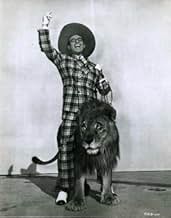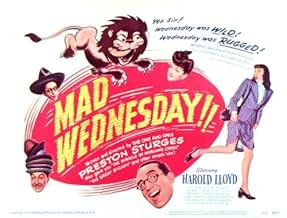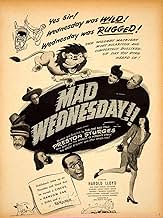IMDb-BEWERTUNG
6,3/10
1811
IHRE BEWERTUNG
Füge eine Handlung in deiner Sprache hinzuHarold is a mild-mannered clerk who dreams about marrying the girl at the desk down the aisle. But then he loses his job, and when he is offered a potent drink at a bar, he goes on a very st... Alles lesenHarold is a mild-mannered clerk who dreams about marrying the girl at the desk down the aisle. But then he loses his job, and when he is offered a potent drink at a bar, he goes on a very strange and funny rampage (with a lion in tow).Harold is a mild-mannered clerk who dreams about marrying the girl at the desk down the aisle. But then he loses his job, and when he is offered a potent drink at a bar, he goes on a very strange and funny rampage (with a lion in tow).
- Auszeichnungen
- 2 Nominierungen insgesamt
Empfohlene Bewertungen
The last laugh of any great clown is interesting, if only for its memento mori value. Laurel & Hardy's last film, UTOPIA, is sadly botched but moments of their grand comedy still flair up, like Marc Antony's final bravery in Shakespeare's Antony & Cleopatra. The grandiose W.C. Fields still holds his own in SONG OF THE OPEN ROAD, even though he was deathly ill with alcohol poisoning. The Marx Brother's LOVE HAPPY is mainly a vehicle for one last pantomime fling for brother Harpo -- and all the more poignant for it. Chaplin's KING IN NEW YORK is a splendid idea -- we chuckle at its conception -- though Chaplin conducts himself like a department store floorwalker more than a comedian. And Harold Lloyd's last movie seems to me to be a nostalgic conspiracy between him and director Sturges, a Last Hurrah to remind movie audiences one last time of the glorious slapstick & pantomime heritage that America was in the process of losing forever as the old clowns faded from the scene and brash lunatics like Martin & Lewis or Bob Hope took over the reins of comedy. Lloyd's film exists in several differently edited versions, but I won't call any of them "butchered", just misunderstood. By the late Forties there weren't any skilled editors around who could quite understand the cadence, the beat, the nearly-balletic timing that a great clown brought to the camera and needed the editor to highlight -- such things as double-takes, long shots of the chase and just stationary shooting when the clown is unfolding a gag. Lloyd produced a novel, a War & Peace, if you will, of vintage gags -- his editors only understood short stories or magazine articles. They grew nervous when the camera lingered on anybody or anything. But great comedy is just that -- lingering. In his final film Lloyd wants to loiter over gags silly and profound. His dawdling is cut short and the truncated comedy that follows seems at times stiff and childish. But before Harold is relegated to the dusty shadows he still pulls off much nonsense that is both genial and brassy -- not a coming attraction, but a dignified retreat back to the Land of Belly Laughs. Anyone grounded in American cinematic comedy feels abit like one of the children in the story of the Pied Piper; we wish we could go with him back into that wonderful, magical, mountain.
"The Sin of Harold Diddlebock" and "Mad Wednesday" are like two twins who hate each other, so they try to change the way they look. Preston Sturges talked Harold Lloyd into coming back to movies after he had retired. Not only that but Lloyd allowed Sturges to use part of his film "The Freshman" for the opening of the film and to be an investor. Their agreement was that each had the final cut of the film. Lloyds' cut is called "The Sin of Harold Diddlebock". Sturges' is called "Mad Wednesday".
Some material is lost on both cuts and some is added. Both are utterly funny with "Mad Wednesday" being a little crazier. Rudy Vallee is almost lost in "Diddlebock" but a major character in "Wednesday". And though both end with Lloyd and Frances Ramsden (The next Mrs. Sturges) in a horse drawn carriage, the last shot of "Wednesday" has the horse singing to the lovers.
If you are interested in how two comic geniuses could shape the same material into two different pictures, then you must see them both. Silly. Funny. Absolutely must sees.
Some material is lost on both cuts and some is added. Both are utterly funny with "Mad Wednesday" being a little crazier. Rudy Vallee is almost lost in "Diddlebock" but a major character in "Wednesday". And though both end with Lloyd and Frances Ramsden (The next Mrs. Sturges) in a horse drawn carriage, the last shot of "Wednesday" has the horse singing to the lovers.
If you are interested in how two comic geniuses could shape the same material into two different pictures, then you must see them both. Silly. Funny. Absolutely must sees.
Between 1940 and 1944, Preston Sturges wrote and directed some of the best film comedy ever produced. His eight movies for that short period are all good, and it would not be an exaggeration to say that four of the eight have the touch of brilliance.
This sequence of movies came to an end when Sturges left Paramount following what he legitimately saw as increasing interference by studio bosses. His high stature at the studio hadn't prevented two of his movies from being taken out of his hands and re-cut against his wishes, one of which - The Great Moment - was never restored to the movie Sturges intended.
At this point, Sturges declined to join a rival studio, and instead formed a partnership with Howard Hughes, hoping to protect his future movies from the interference he could see was becoming more common within the studio system. However, for a combination of reasons, this partnership with Hughes was not a success, and the only film Sturges produces in that period - The Sin of Harold Diddlebock - shows a decline in his work.
The whole look and sound of the movie is inferior. It is impossible to know whether this decline was the result of an inevitable burn-out in his ability after such sustained success, or the absence of support and quality control that Paramount had applied to the benefit of the wonderful movies that had come before.
So... to "Diddlebock" itself! It is difficult to identify why it isn't as funny as we might expect. The film was created as a star vehicle for Harold Lloyd, and by all accounts his comedy instincts did not match those of Sturges. As much as Stuges tried, clearly such a big talent and personality as Lloyd was never going to completely submit to direction with which he didn't agree, and there must be some evidence of that in what we see on screen.
There is a complete lack of the 'sparkle' we have come to expect. The familiar faces around Lloyd remind us of the great Sturges movies, but to me this is like an inferior pastiche of a Sturges movie by a lesser hand, without such a reliable instinct for film comedy. But perhaps that describes what Preston Sturges had become in such a short time.
This sequence of movies came to an end when Sturges left Paramount following what he legitimately saw as increasing interference by studio bosses. His high stature at the studio hadn't prevented two of his movies from being taken out of his hands and re-cut against his wishes, one of which - The Great Moment - was never restored to the movie Sturges intended.
At this point, Sturges declined to join a rival studio, and instead formed a partnership with Howard Hughes, hoping to protect his future movies from the interference he could see was becoming more common within the studio system. However, for a combination of reasons, this partnership with Hughes was not a success, and the only film Sturges produces in that period - The Sin of Harold Diddlebock - shows a decline in his work.
The whole look and sound of the movie is inferior. It is impossible to know whether this decline was the result of an inevitable burn-out in his ability after such sustained success, or the absence of support and quality control that Paramount had applied to the benefit of the wonderful movies that had come before.
So... to "Diddlebock" itself! It is difficult to identify why it isn't as funny as we might expect. The film was created as a star vehicle for Harold Lloyd, and by all accounts his comedy instincts did not match those of Sturges. As much as Stuges tried, clearly such a big talent and personality as Lloyd was never going to completely submit to direction with which he didn't agree, and there must be some evidence of that in what we see on screen.
There is a complete lack of the 'sparkle' we have come to expect. The familiar faces around Lloyd remind us of the great Sturges movies, but to me this is like an inferior pastiche of a Sturges movie by a lesser hand, without such a reliable instinct for film comedy. But perhaps that describes what Preston Sturges had become in such a short time.
Harold Lloyd was one of Hollywood's greatest physical comedians and actors of Buster Keaton and Charlie Chaplin generation. This film marks his final performance but he could have done so much more in film. Regardless, his contributions should not be overlooked. Harold Lloyd plays Harold Dibbledock, a former football players, who ends up at a dead-end job as a clerk for 22 years. His ungrateful boss sends him packing after he fires him for years of service which was more like a prison sentence than a job. He never relived his glory days on the field. When he encounters an old man who seeks a few dollars to play the horses, he begins a new life after he takes a drink. Until then, Harold has never drank alcohol. He awakens up to learn that he's changed and doesn't have a clue about it. Margaret Hamilton plays Flora in a small performance. Anyway, he learns that he's bought a cab with a driver and a horse and a circus. Anyway, the film's best scenes are stolen by Jackie, the lion. It's a good film!
In 1947 Preston Sturges and Harold Lloyd worked together and they came up with The Sin of Harold Diddlebock.It's a sequel for Lloyd's silent film classic The Freshman (1925).After this movie Mr.Lloyd retired from the movie business.In his last picture Harold plays a clerk who's fired from his job after twenty years.He ends up to a bar drinking and the man goes crazy.Also a lion in tow gets in a picture and lots of other funny stuff happens on a way.This movie may not be the best of Harold Lloyd, not even close, but it's mighty entertaining.And because of Harold Lloyd this movie works much better than it would have with some average comedian.Lloyd was far from average.He was Lonesome Luke and he was Glasses, which was the character that made him immortal.Lloyd may steal the show in this movie, but there are other great actors there.I could mention Jimmy Conlin, Raymond Walburn, Rudy Wallee and Edgar Kennedy.I recommend you to watch this film from 60 years back.For the Harold Lloyd fans it's a must.
Wusstest du schon
- WissenswertesDuring the scene where Harold Lloyd's character meets Jackie the lion, on the first take when Lloyd pets Jackie, the lion actually bit him on his right hand. However, he was not injured because the lion's teeth scraped against his two prosthetic fingers (Lloyd had lost most of his right hand in an on-set accident in 1919). After that, he refused to pet the lion ever again on- or off-screen, and in the second take, which was used for the film, his terrified squirming over the lion standing next to him is genuine.
- PatzerThe story takes place in New York. It is odd to see Los Angeles City Hall in the background of the final shot.
- Crazy Credits"... and for the first time a young girl called Frances Ramsden playing the youngest Miss Otis"
- Alternative VersionenOriginally released at 90 minutes; was then re-edited and re-released in a shorter 79-minutes version under the title "Mad Wednesday" in 1950.
- VerbindungenEdited from Harold Lloyd, der Sportstudent (1925)
- SoundtracksAmerica, the Beautiful
(uncredited)
Music by Samuel A. Ward
Played during the presidential calendar montage
Top-Auswahl
Melde dich zum Bewerten an und greife auf die Watchlist für personalisierte Empfehlungen zu.
- How long is The Sin of Harold Diddlebock?Powered by Alexa
Details
- Erscheinungsdatum
- Herkunftsland
- Sprache
- Auch bekannt als
- The Sin of Harold Diddlebock
- Drehorte
- Memorial Stadium - Stadium Rim Way, Berkeley, Kalifornien, USA(football scenes edited from The Freshman)
- Produktionsfirma
- Weitere beteiligte Unternehmen bei IMDbPro anzeigen
Box Office
- Budget
- 1.712.959 $ (geschätzt)
- Laufzeit1 Stunde 29 Minuten
- Farbe
- Seitenverhältnis
- 1.37 : 1
Zu dieser Seite beitragen
Bearbeitung vorschlagen oder fehlenden Inhalt hinzufügen

Oberste Lücke
By what name was Verrückter Mittwoch (1947) officially released in Canada in English?
Antwort





































